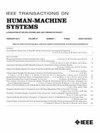Fatigue Assessment and Control With Lower Limb Exoskeletons
IF 4.4
3区 计算机科学
Q2 COMPUTER SCIENCE, ARTIFICIAL INTELLIGENCE
引用次数: 0
Abstract
Acknowledging the vital importance of fatigue management for improving rehabilitation results, customizing treatment, safeguarding patient well-being, and enhancing the quality of life of hemiplegic patients, this study presents the development of a tailored fatigue model and a corresponding human-in-the-loop (HiL) control system for exoskeleton-assisted walking. For this, the selected three-compartment controller fatigue model including a resting recovery parameter was adapted to a dynamic walking task scenario, incorporating a torque–velocity–angle dependency to quantify muscle activity. The model parameters were experimentally verified in a study with six healthy subjects, demonstrating accurate prediction of maximum voluntary contraction (MVC) decline with an average mean absolute error of 4.9%MVC. Subsequently, an HiL control mechanism was developed, utilizing ratings of perceived fatigue and state of fatigue values as reference metrics. The presented control approach effectively regulates fatigue levels within a 0%MVC–6%MVC steady-state error range during simulations. Experimental validation confirmed this performance, however, with partly higher steady-state errors mainly due to the restrictions of the exoskeleton's assistance. This preliminary study provides a promising foundation for future research, demonstrating the potential to manage fatigue effectively in exoskeleton users, offering an improved, personalized experience.下肢外骨骼的疲劳评估与控制
认识到疲劳管理对于改善康复效果、定制治疗、保障患者福祉和提高偏瘫患者生活质量的重要性,本研究提出了针对外骨骼辅助行走的定制疲劳模型和相应的人在环(HiL)控制系统的开发。为此,所选择的包含静息恢复参数的三室控制器疲劳模型适用于动态步行任务场景,结合扭矩-速度角依赖性来量化肌肉活动。在6名健康受试者的实验中验证了模型参数的准确性,平均绝对误差为4.9%,可以准确预测最大自主收缩(MVC)下降。随后,开发了一种HiL控制机制,利用感知疲劳等级和疲劳状态值作为参考指标。在仿真过程中,所提出的控制方法在0%MVC-6%MVC稳态误差范围内有效地调节了疲劳水平。实验验证证实了这一性能,然而,部分较高的稳态误差主要是由于外骨骼的辅助限制。这项初步研究为未来的研究提供了有希望的基础,展示了有效管理外骨骼用户疲劳的潜力,提供了改进的个性化体验。
本文章由计算机程序翻译,如有差异,请以英文原文为准。
求助全文
约1分钟内获得全文
求助全文
来源期刊

IEEE Transactions on Human-Machine Systems
COMPUTER SCIENCE, ARTIFICIAL INTELLIGENCE-COMPUTER SCIENCE, CYBERNETICS
CiteScore
7.10
自引率
11.10%
发文量
136
期刊介绍:
The scope of the IEEE Transactions on Human-Machine Systems includes the fields of human machine systems. It covers human systems and human organizational interactions including cognitive ergonomics, system test and evaluation, and human information processing concerns in systems and organizations.
 求助内容:
求助内容: 应助结果提醒方式:
应助结果提醒方式:


